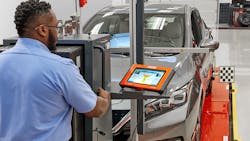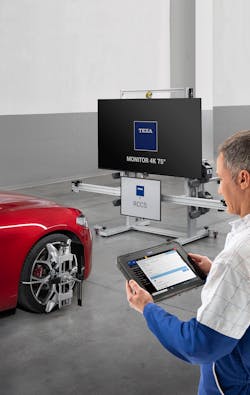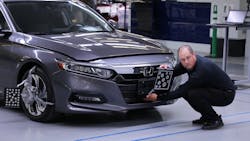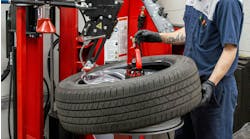Installing plus-size tire and wheel combinations can sometimes change a vehicle’s ride height. What impact could that have on advanced driver assistance systems (ADAS?) What do installers need to keep in mind when it comes to ADAS?
In this article, representatives from Autel North America, Bosch Automotive Aftermarket, Hunter Engineering Co., Snap-on Inc., TEXA USA and Vehicle Service Group (VSG) share tips and best practices.
Can the installation of plus-sized, aftermarket tire and wheel packages on a vehicle impact that vehicle’s ADAS? If so, how? What are some effects and what do tire/wheel installers need to be aware of?
Richard Zenteno, national sales manager, ADAS, Autel North America: Vehicles that have been raised or the steering and suspension modified will affect the ADAS systems, especially the forward-facing sensors.
Scott McKinney, senior product manager, Bosch Automotive Aftermarket North America: The general rule is that as long as the tires — or even a lift kit — are within the specs of a dealer-installed package, it’s not a problem for calibration. However, if a plus-sized tire falls outside the standard wheel size, ADAS systems would most likely still calibrate and operate, but not in the way the (original equipment manufacturer) intended.
Ryan Gerber, product specialist, ADAS, Hunter Engineering Co.: Yes. The plus-sized package creates a different ride height by altering the manufacturer’s aiming of ADAS sensors. Effects can be wide-ranging depending on various factors. (Original equipment vehicle manufacturers) have statements and/or information regarding these types of packages that in some cases provide guidance for calibration.
Jordan Krebs, product manager, Americas, wheel alignment and ADAS, Snap-on Inc.: One thing that will never change in the automotive world is the fact that automotive enthusiasts will always want to be able to modify their vehicle to match their personality — whether it be through lift kits, aftermarket tire and wheel packages, paint jobs or aftermarket body panels.
These modifications can affect ADAS calibrations on a vehicle as most ADAS systems are mounted to the body or chassis and rely on suspension angles — namely total toe, steering, thrust, track width and ride height angles — to be in proper alignment before calibrating.
When modifying any part of a vehicle with aftermarket parts, technicians need to review the OEM service information for that specific vehicle, as each manufacturer has a different stance on the subject of vehicle modification. Suppose the modifications a technician makes result in the car’s geometry changing in any way? In that case, there is a potential for ADAS sensors to fail to function properly, which could result in a safety system failure that causes injury or death.
TEXA USA tech support team: The installation of enlarged-sized wheels on a vehicle increases the ride height of the vehicle and the height of the sensor field of visibility. If the sensor height is increased, the distance for the visibility is increased, which may alter the distance for the warning or reaction time of the system.
In some cases, where the rear wheels are larger than the front, the vehicle may be pointed at a steeper angle than originally designed and cut down on the sensor field of visibility, which might eliminate the warning or reaction time for the system.
Lee Daugherty, vice president, ADAS sales and development, chief collision technology, VSG: The modification of tire/wheel size from the original equipment specifications absolutely has an impact on a vehicle’s ADAS systems. When changing the ride height — the distance from the highest point on the fender well to the ground of the vehicle — by either raising, lowering or changing the relationship of front to rear, the ADAS sensors/cameras are in a different orientation than they were from the factory.
You can equate it to standing upright and looking at something and then squatting down and looking at the same object. Your perspective changes. Changing the ride height of a vehicle has the same effect on the ADAS sensors.
By changing the tire/wheel size, the driver is going to experience changes to how the vehicle’s ADAS systems react on the road. The cameras/sensors are now looking from a different perspective and may react quicker, slower or not at all to (the) driving situations you encounter.
What are some ADAS-related scenarios that could be created by the installation of plus-size tire/wheel packages, and do they create situations where ADAS will need to be recalibrated?
Zenteno (Autel): Think about a straight road, where the left and right sides meet at the horizon. That point is called the “vanishing point.” For ADAS — including critical systems like collision warning — to work, they need a point of reference to make their calculations.
When you alter the vehicle’s position — be it by means of modifying the tire size or suspension’s height or the physical direction of travel — you alter the point of reference that the ADAS sensor uses to accurately calculate and warn and/or brake.
McKinney (Bosch): Changing the tire size alters the ride height of the vehicle and has the potential to create blind spots that the sensors would normally be able to detect. Alternatively, the vehicle might miscalculate the data from the sensors due to the different orientations from the ride height difference.
Gerber (Hunter): The scenarios created by the plus-sized packages are being studied by the Specialty Equipment Market Association. In an arbitrary scenario, a vehicle’s ride height is altered upward by 3-inches. The sensors’ current calibration would need to be recalibrated to this new ride height.
Krebs (Snap-on): Luckily, most manufacturers understand that customers will modify their vehicles in one way or another and have provided instructions and limitations on the modifications that can be done to a vehicle with ADAS sensors before the ADAS must be disabled.
Again, referring to the OEM service information related to alignment and ADAS before beginning vehicle modifications with aftermarket parts is always important. Here are some examples:
Example one: One manufacturer states that if a vehicle’s ride height — whether lift/lowering kit or wheel/tire combination — is within 4 inches of stock, recalibration is OK to proceed. Otherwise, (you must) disable ADAS on the vehicle. Most wheel and tire combinations will not result in a ride height change of more than 4 inches, so a typical shop may not have to worry about any liability. However, they would be best covered if they were to have a way to show that they referenced the OEM service information before making the modifications.
Example two: Another manufacturer states that if a vehicle’s height has changed at all, it must be brought back to stock before recalibrating. Adding an aftermarket bumper to add clearance for oversized wheels and tires would necessitate an ADAS calibration, per the manufacturer. In this case, replacing the bumper, performing ADAS calibration and then installing the new wheels and tires would be best. If a shop tried to do it all at once and did not perform any calibrations and the vehicle was involved in an accident, the shop could be potentially liable for the accident.
As you can see, when it comes to ADAS, quality and adherence to OEM (specifications) are vital to reducing potential liability. The risks involved with an improper ADAS calibration far outweigh any costs associated with adhering to the proper OEM procedures.
Reducing liability is key, and the easiest way to do so when it comes to ADAS is to adhere to the OEM service information without fail. Should a vehicle with aftermarket wheels and tires or suspension changes be involved in an accident where the vehicle’s ADAS sensors failed to warn the driver or take corrective action, the blame could come back to the last shop to touch the vehicle.
TEXA: If the vehicle height is altered, an ADAS calibration is required to adjust all the sensor visibilities to confirm the correct distance is being judged by the vehicle ADAS system.
Daugherty (VSG): An example would be that you install plus-sized tire/wheels on a vehicle and now the adaptive cruise control does not sense the vehicle in front of you, which is going slower than you, and does not slow you down as you approach it because it is looking over the vehicle instead of at the rear of the vehicle.
If you installed a tire/wheel package that lowered the front ride height and raised the rear, you would create the same kind of situation where the vehicle will react too slowly to the vehicle you are approaching because the vehicle is looking down and not straight ahead.
If you change the ride height by raising the front and lowering the rear, you can create a situation that the vehicle’s automatic emergency braking (AEB) is activated when you approach an overpass on the expressway. It thinks the overpass is a stopped vehicle on the roadway and incorrectly applies the emergency braking system and the vehicle comes to an abrupt stop on the expressway, creating a very dangerous situation.
Anytime you change the ride height to something different than the original vehicle design, the ADAS systems need to be recalibrated. This can be somewhat tricky as there are no OEM repair procedures for recalibrating a vehicle with a modified ride height.
The other thing to keep in mind is that even removing the front bumper cover, adding a bumper guard, changing the grill or replacing the windshield will potentially require a recalibration of the ADAS systems.
What are two or three things that tire/wheel installers need to know about ADAS?
Zenteno (Autel): As mentioned before, when you alter the vehicle’s position or direction of travel, you are altering the system’s performance and response time.
There are many scenarios that can lead to malfunctions — for example, a truck that had a lift kit installed and now the adaptive cruise control no longer detects the vehicle in front of it due to the new position of the forward-facing radar; the vehicle that was recently aligned and the ACC kept braking because the forward-facing sensor was seeing the vehicle in the lane beside it, thinking it was directly in front; or the lane departure system that was warning too early.
McKinney (Bosch): ADAS are vehicle technologies designed to improve driver safety by assisting drivers on the road. A few examples of ADAS include lane-keeping assist, automatic emergency braking and the very common rear back-up camera, which has been required on all new vehicles under 10,000 pounds since 2018.
ADAS technology works through the combination of cameras and sensors to collect and process information to assist in a safe driving experience. Recalibrating ADAS sensors can be quite difficult as electrical signals from other components in a vehicle may interfere with the tech, making it appear that the ADAS sensor has an issue when this may not be the case — causing confusion and frustration for technicians who are unfamiliar with recalibration techniques.
When recalibrating a sensor, it’s best practice to determine the working status of other sensors in the vehicle to eliminate the possibility of electrical signals from other components interfering with the original sensor.
Gerber (Hunter): ADAS is an opportunity to increase driver safety, as well as an opportunity to realize a new revenue stream. Like all new technology, there is a (learning) curve, and it’s not altogether difficult. ADAS is now mandatory with automatic emergency braking (AEB), so it is on all cars.
Krebs (Snap-on): ADAS stands for advanced driver assistance systems — with the key word being “assistance.” These systems are only a partial solution for automated driving. When it comes to vehicle driving automation, there are six levels:
- Level Zero: No automation whatsoever;
- Level 1: Mode-specific minor assistance of steering, braking or accelerating;
- Level 2: Mode-specific increased assistance or takeover of steering, braking and accelerating;
- Level 3: Mode-specific automated driving of all dynamic tasks with human intervention, when requested;
- Level 4: Mode-specific automated driving of all dynamic tasks, even when human does not respond, and;
- Level 5. Full-time automated driving under all road/weather conditions, without the need for any human interaction.
There are two types of ADAS systems on cars today: active and passive. Active systems will work to reduce accidents, such as automatic emergency braking, lane keep assist and automatic cruise control. Passive systems are just there to inform the driver, such as pedestrian recognition, traffic sign recognition, surround view, backup camera and night vision.
Similarly, there are two types of ADAS calibrations for systems on cars today and they vary by manufacturer and model: static and dynamic.
Static calibrations typically take place in a controlled environment — in a shop bay where targets are positioned in key locations around the vehicle and the vehicle is told to initialize a calibration and look for said targets to calibrate. These are most of your Asian import vehicles.
Dynamic calibrations are performed while driving the vehicle in a target-rich environment but are subject to longer calibration times if there is inclement weather, a lack of traffic or too much traffic. These are most of your domestic vehicles.
TEXA: One essential ADAS calibration lesson is not all calibration systems are created equal.
Daughtery (VSG): Examples of systems are adaptive cruise control, blind spot monitoring, cross traffic alert, advanced collision warning, AEB, lane keep, etc. There are two classifications for these systems: passive and active.
A passive system will simply alert the driver to an impeding situation by giving an audible sound and/or flash a light or display a message. Examples of these are blind spot warning or lane assist. An active system will actually take some type of action automatically without driver intervention. Examples of active systems are adaptive cruise control, AEB, lane centering, etc. Since September 2022, every vehicle manufacturer has agreed to make AEB standard on all new vehicles made.







